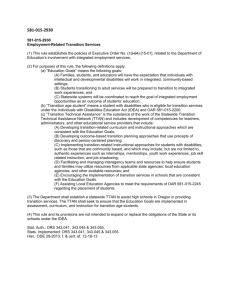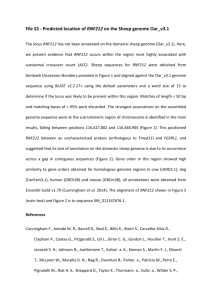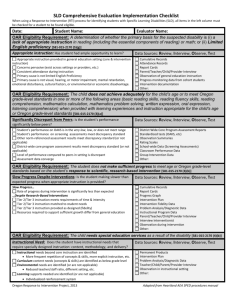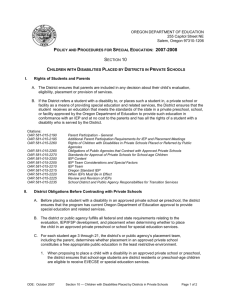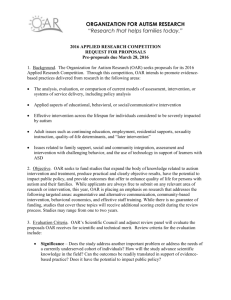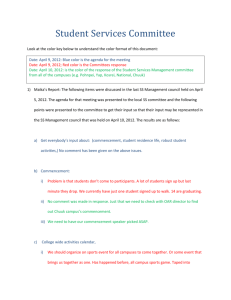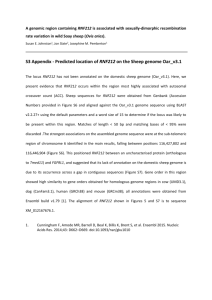Evaluation and Eligibility - Oregon Department of Education
advertisement
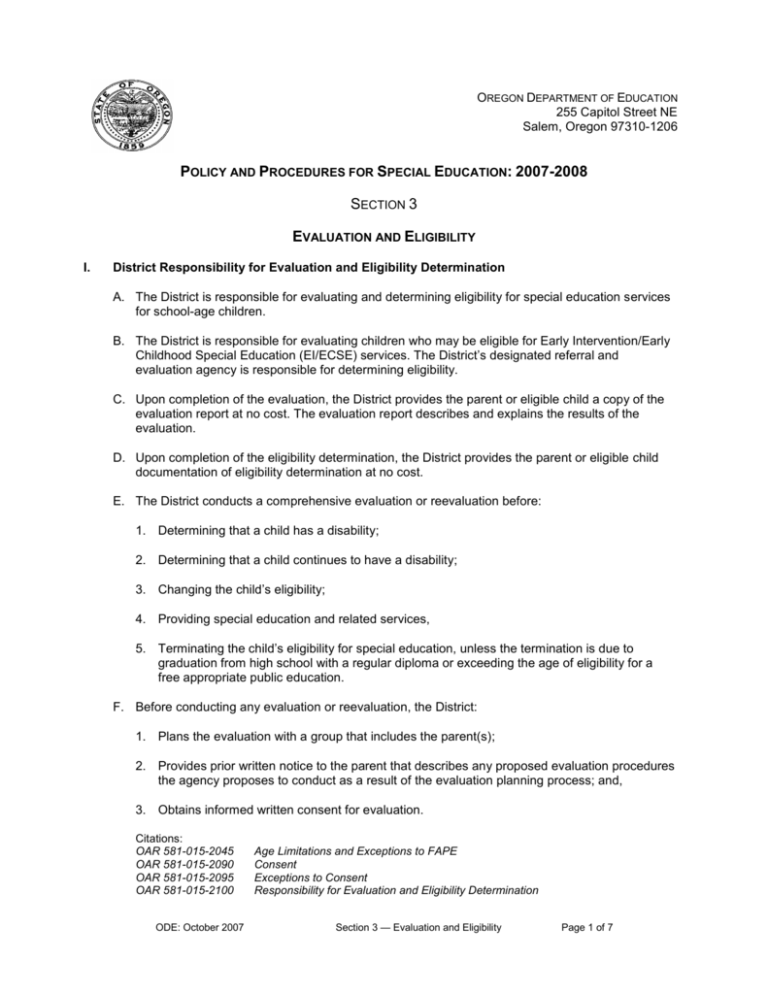
OREGON DEPARTMENT OF EDUCATION 255 Capitol Street NE Salem, Oregon 97310-1206 POLICY AND PROCEDURES FOR SPECIAL EDUCATION: 2007-2008 SECTION 3 EVALUATION AND ELIGIBILITY I. District Responsibility for Evaluation and Eligibility Determination A. The District is responsible for evaluating and determining eligibility for special education services for school-age children. B. The District is responsible for evaluating children who may be eligible for Early Intervention/Early Childhood Special Education (EI/ECSE) services. The District’s designated referral and evaluation agency is responsible for determining eligibility. C. Upon completion of the evaluation, the District provides the parent or eligible child a copy of the evaluation report at no cost. The evaluation report describes and explains the results of the evaluation. D. Upon completion of the eligibility determination, the District provides the parent or eligible child documentation of eligibility determination at no cost. E. The District conducts a comprehensive evaluation or reevaluation before: 1. Determining that a child has a disability; 2. Determining that a child continues to have a disability; 3. Changing the child’s eligibility; 4. Providing special education and related services, 5. Terminating the child’s eligibility for special education, unless the termination is due to graduation from high school with a regular diploma or exceeding the age of eligibility for a free appropriate public education. F. Before conducting any evaluation or reevaluation, the District: 1. Plans the evaluation with a group that includes the parent(s); 2. Provides prior written notice to the parent that describes any proposed evaluation procedures the agency proposes to conduct as a result of the evaluation planning process; and, 3. Obtains informed written consent for evaluation. Citations: OAR 581-015-2045 OAR 581-015-2090 OAR 581-015-2095 OAR 581-015-2100 ODE: October 2007 Age Limitations and Exceptions to FAPE Consent Exceptions to Consent Responsibility for Evaluation and Eligibility Determination Section 3 — Evaluation and Eligibility Page 1 of 7 OAR 581-015-2105 OAR 581-015-2110 OAR 581-015-2115 OAR 581-015-2120 OAR 581-015-2130 OAR 581-015-2135 OAR 581-015-2140 OAR 581-015-2145 OAR 581-015-2150 OAR 581-015-2155 OAR 581-015-2160 OAR 581-015-2165 OAR 581-015-2170 OAR 581-015-2175 OAR 581-015-2180 OAR 581-015-2310 OAR 581-015-2790 OAR 581-015-2795 II. Evaluation and Reevaluation Requirements General Evaluation and Reevaluation Procedures Evaluation Planning Determination of Eligibility Autism Spectrum Disorder Communication Disorder Deafblindness Emotional Disturbance Hearing Impairment Mental Retardation Orthopedic Impairment Other Health Impairment Specific Learning Disability Traumatic Brain Injury Vision Impairment Prior Written Notice ECSE Evaluation ECSE Eligibility Request for Initial Evaluation A. Consistent with its child find and parent consent obligations, the District responds promptly to requests initiated by a parent or public agency for an initial evaluation to determine if a child is a child with a disability. B. Upon receiving a request from a parent or public agency for an initial evaluation, the District designates a team to determine whether an initial evaluation will be conducted. 1. The District team includes the parent and at least two professionals, at least one of whom is a specialist knowledgeable and experienced in the evaluation and education of children with disabilities. a. The team may make the decision to evaluate with or without a meeting. b. The District documents team member’s input, including parents, whether or not the District convenes a meeting. c. If a meeting is held, the District invites parents to participate. d. If the District agency refuses an evaluation requested by the parent, the District provides the parent with prior written notice of its refusal to conduct an evaluation. e. The District acknowledges the parent’s right to challenge its refusal to conduct an evaluation. 2. The initial evaluation consists of procedures a. To determine if the child has a disability; and, b. To identify the child’s educational needs. C. The District conducts the initial evaluation within 60 school days of receiving parental consent for evaluation, unless: 1. The District and the parents agree in writing to extend the timeline for an evaluation to determine eligibility for specific learning disabilities; ODE: October 2007 Section 3 — Evaluation and Eligibility Page 2 of 7 2. The child moves from another school district during the evaluation, the District is making sufficient progress to ensure a prompt completion of the evaluation, and the parent and the District agree in writing to a specific time when the evaluation will be completed. 3. The parent repeatedly fails or refuses to produce the child for the evaluation. Citations: OAR 581-015-2080 OAR 581-015-2090 OAR 581-015-2095 OAR 581-015-2105 OAR 581-015-2110 OAR 581-015-2115 OAR 581-015-2170 OAR 581-015-2190 OAR 581-015-2345 III. Child Find Consent Exceptions to Consent Evaluation and Reevaluation Requirements General Evaluation and Reevaluation Procedure Evaluation Planning Specific Learning Disability Parent Participation Requirements Hearing Request and Response Reevaluation A. The District conducts reevaluations: 1. When the educational or related services needs, including improved academic achievement and functional performance, of the child warrant a reevaluation; 2. When the child’s parents or teacher requests a reevaluation; and 3. At least every three years, unless that parent and the District agree that a reevaluation is unnecessary. B. The District does not conduct reevaluation more than once a year, unless the parent and District agree otherwise. Citations: OAR 581-015-2105 OAR 581-015-2110 IV. Evaluation and Reevaluation Requirements General Evaluation and Revaluation Procedures Evaluation Planning: A. The District, or designated referral and evaluation agency for preschool children, ensures that, as part of an initial evaluation (if appropriate), the child’s IEP or IFSP team, including the parents, and other qualified professionals, as appropriate, review and document their review of existing evaluation data on the child, including: 1. Evaluations and information provided by the child’s parent(s); 2. Current classroom-based, local, or state assessments, and classroom-based observations; and, 3. Observations by teachers and related services providers. B. On the basis of that review and input from the child’s parents, identify what additional data, if any, are needed to determine: 1. Whether the child has a disability; 2. The child’s present levels of academic achievement and related developmental needs; ODE: October 2007 Section 3 — Evaluation and Eligibility Page 3 of 7 3. Whether the child needs, or continues to need, EI/ECSE or special education and related services; and, 4. For reevaluation, whether the child needs any additions or modifications to special education and related services or, for a preschool child, any additions or modifications to ECSE services: a. To enable the child to meet the measurable annual goals in the child’s IEP or IFSP; and, b. To participate, as appropriate, in the general education curriculum or, for preschool children, appropriate activities. Citations: OAR 581-015-2115 V. Evaluation Planning Evaluation Procedures A. The District assesses the child in all areas related to the suspected disability, including, if appropriate, health, vision, hearing, social and emotional status, general intelligence, academic performance, communicative status, and motor abilities; B. The evaluation is sufficiently comprehensive to identify all of the child’s special education and related services needs, whether or not commonly linked to the disability category in which the child has been classified. C. The evaluation includes information provided by the parent and a variety of assessment tools and strategies to gather relevant functional, developmental, and academic information about the child that assist in determining: 1. Whether the child has a disability; and, 2. The content of the child’s IEP, including information related to enabling the child to be involved in and progress in the general education curriculum (or for a preschool child, to participate in appropriate activities. C. The District ensures that assessments and other evaluation materials, including those tailored to assess specific areas of educational need, used to assess a child: 1. Are selected and administered so as not to be discriminatory on a racial or cultural basis; 2. Are provided and administered in the child’s native language or other mode of communication and in the form most likely to yield accurate information on what the child knows and can do academically, developmentally, and functionally, unless it is clearly not feasible to do so; 3. Are used for the purposes for which the assessments or measures are valid and reliable; 4. Are administered by trained and knowledgeable personnel; and, 5. Are administered in accordance with any instructions provided by the producer of the assessments. D. The District selects and administers assessments to ensure that if an assessment is administered to a child with impaired sensory, manual, or speaking skills, the assessment results accurately reflect the child’s aptitude or achievement level or whatever other factors the test purports to ODE: October 2007 Section 3 — Evaluation and Eligibility Page 4 of 7 measure, rather than reflecting the child’s impaired sensory, manual, or speaking skills (unless those skills are the factors that the test purports to measure). E. The District uses technically sound instruments that may assess the relative contribution of cognitive and behavioral factors, in addition to physical or developmental factors. F. The District does not use any single measure or assessment as the sole criterion for determining whether a child is a child with a disability and for determining an appropriate educational program for the child. Citations: OAR 581-015-2110 OAR 581-015-2130 OAR 581-015-2135 OAR 581-015-2140 OAR 581-015-2145 OAR 581-015-2150 OAR 581-015-2155 OAR 581-015-2160 OAR 581-015-2165 OAR 581-015-2170 OAR 581-015-2175 OAR 581-015-2180 OAR 581-015-2790 VI. General Evaluation and Reevaluation Procedures Autism Spectrum Disorder Communication Disorder Deafblindness Emotional Disturbance Hearing Impairment Mental Retardation Orthopedic Impairment Other Health Impairment Specific Learning Disability Traumatic Brain Injury Vision Impairment ECSE Evaluation Requirements If Additional Evaluation Data Are Not Needed to Determine Eligibility A. If the child’s IEP or IFSP team determines that no additional data are needed to determine whether the child is or continues to be a child with a disability, and to determine the child’s educational and developmental needs, the District provides prior written notice of that decision, the reasons for it, and the right of parents to request an assessment. B. When the IEP or IFSP team determines that no additional data are needed to determine eligibility, the District does not conduct an assessment of the child unless requested to do so by the parents. Citations: OAR 581-015-2115 VII. Evaluation Planning Evaluation Procedures for Transfer Students When a child with disabilities transfers from one school district to another school district in the same school year, the District coordinates with the previous school district to complete any pending assessments as quickly as possible. Citations: OAR 581-015-2110 VIII. General Evaluation and Reevaluation Procedures Eligibility Determination A. Once evaluation is completed, the District designates an eligibility team to determine whether the child is eligible for special education services. B. This team includes: 1. Two or more professionals, one of whom will be knowledgeable and experienced in evaluating and teaching students with the suspected disability; and, ODE: October 2007 Section 3 — Evaluation and Eligibility Page 5 of 7 2. The student’s parent(s). 3. For consideration of eligibility in the area of specific learning disabilities, the District eligibility team includes: a. A group of qualified professionals and the parent; b. The child's regular classroom teacher or, if the child does not have a regular classroom teacher, a regular classroom teacher qualified to teach a child of his or her age, or, for a child of less than school age, a preschool teacher; and, c. A person qualified to conduct individual diagnostic examinations of children, such as a school psychologist, speech-language pathologist, or other qualified professional. C. In interpreting evaluation data each District team carefully considers and documents information from a variety of sources, including but not limited to, aptitude and achievement tests, teacher recommendations, physical condition, social or cultural background and adaptive behavior and all required elements of the evaluation. D. Each eligibility team prepares a written eligibility statement that includes: 1. Identification of the evaluation data considered in determining the child’s eligibility, including the required evaluation components for the disability under consideration; 2. A determination of whether the child meets the minimum evaluation criteria for one or more of the disability categories in Oregon Administrative Rule; 3. A determination of whether the primary basis for the suspected disability is: a. A lack of appropriate instruction in reading (including the essential components of reading) or math; or, b. Limited English proficiency; 4. A determination of whether the child's disability has an adverse impact on the child's educational performance; 5. A determination of whether, as a result of the disability, the child needs special education services; 6. The signature of every team member and an indication of whether each agrees with the eligibility determination; 7. For a child suspected of having a specific learning disability, the team's written report includes additional specific documentation as required by Oregon Administrative Rule. E. The team does not find a child eligible as a child with a disability if: 1. The determinant factor for that eligibility decision is: a. Lack of appropriate instruction in reading, including the essential components of reading instruction, or lack of appropriate instruction in math; or, b. Limited English proficiency; and, ODE: October 2007 Section 3 — Evaluation and Eligibility Page 6 of 7 c. The child does not otherwise meet the eligibility criteria found in Oregon Administrative Rule for the category(ies) of disability under consideration. F. The team finds a child eligible if the child has a disability and needs special education and related services, even though the child is advancing from grade to grade. G. A child may have disabilities in more than one disability category, but the team needs to find the child eligible under only one category. However, the District evaluates the child in all areas related to the suspected disability or disabilities, and the child's IEP addresses all of the child's special education needs. Citations: OAR 581-015-2120 OAR 581-015-2125 OAR 581-015-2130 OAR 581-015-2135 OAR 581-015-2140 OAR 581-015-2145 OAR 581-015-2150 OAR 581-015-2155 OAR 581-015-2160 OAR 581-015-2165 OAR 581-015-2170 OAR 581-015-2175 OAR 581-015-2180 ODE: October 2007 Determination of Eligibility Interpretation of Evaluation Data Autism Spectrum Disorder Communication Disorder Deafblindness Emotional Disturbance Hearing Impairment Mental Retardation Orthopedic Impairment Other Health Impairment Specific Learning Disability Traumatic Brain Injury Vision Impairment Section 3 — Evaluation and Eligibility Page 7 of 7
